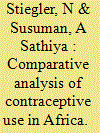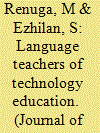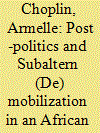|
|
|
Sort Order |
|
|
|
Items / Page
|
|
|
|
|
|
|
| Srl | Item |
| 1 |
ID:
147326


|
|
|
|
|
| Summary/Abstract |
The aim of this article is to show a comparative analysis of contraceptive use in areas of traditionally high fertility that have gone through profound changes. Data have been taken from the latest Demographic and Health Surveys (DHS). Logistic regression models were adopted for four selected representative countries, namely Egypt, Mali, Namibia and Niger. There were two selection criteria: data should be recent, and selected countries should have high (Egypt 57.4%; Namibia 46.4%) or low (Mali 7.5%; Niger 10.0%) contraceptive use. The probability of using contraception when a woman has had one to four children is 2.4 times higher than when they have had no children. Contraception data are always gathered at a point of time, but cross-sectional data are not sufficient to understand all the mechanisms hidden behind contraceptive use. Different contraceptive behaviours need good estimation tools to develop specific family planning programmes.
|
|
|
|
|
|
|
|
|
|
|
|
|
|
|
|
| 2 |
ID:
147329


|
|
|
|
|
| Summary/Abstract |
Although the Black student population in South Africa now amounts to 72% of student enrolments in higher education, the same trend is not experienced in early childhood education (ECE). Research suggests that cultural and linguistic differences between home communities and university settings as well as meeting the academic demands of an institution that is unfamiliar with students’ home languages and cultures can be overwhelming. Using the Force Field Model of Professional Development as a theoretical lens, the experiences of Black students are explored at a previous White university. Findings from focus group interviews indicate that financial restraints, unfamiliar teaching practices and language barriers are amongst the factors that are experienced as barriers and could serve as reasons for the low enrolment in ECE.
|
|
|
|
|
|
|
|
|
|
|
|
|
|
|
|
| 3 |
ID:
147330


|
|
|
|
|
| Summary/Abstract |
This study looked at the challenges, needs and transformations of the technology education language teachers who responded to questionnaires and extensive interviews. In total, 88 teachers from 20 institutions, heads of English departments and placement professionals of engineering institutions were involved in the study. It was found that hands-on communication and soft skills training in industry was the uppermost need. The lack of industry exposure and opportunities to articulate is the highest challenge. The heads of department revealed that industrial collaboration is the highest priority. The placement professionals made the point that institutions need to develop communication skills with respect to the current trends in industry.
|
|
|
|
|
|
|
|
|
|
|
|
|
|
|
|
| 4 |
ID:
147331


|
|
|
|
|
| Summary/Abstract |
This historical essay critically examines the early military settlement projects realized by the French Engineering Corps in Senegal and the Western Sudan during the second half of the 19th century. The French were preoccupied with the establishment of official control over the hinterland, confronting a variety of challenges in situ. In striving to go beyond the prestigious image of the Corps and the discourse on colonial settlement forms as an instrument for domination, this article exposes aspects of uncertainty and haphazardness behind the projects. Visual correspondence with indigenous cultures is expanded, employing a rich variety of historical sources.
|
|
|
|
|
|
|
|
|
|
|
|
|
|
|
|
| 5 |
ID:
147328


|
|
|
|
|
| Summary/Abstract |
This article discusses factors that shaped the initiation and escalation of the Jarso–Girhi violence that occurred two decades ago. The data required for the study were collected from community leaders, ordinary members of the communities, and administrative and political officers. The data were collected through one-on-one interviews, focus group discussions and field observations. The study shows that the inter-communal violence was the result of convergence and interaction between historical, ethnopolitical, sociocultural and psychosocial factors. The study reveals the impact of ethnically based mobilization in stoking underlying communal cleavages, in breaking trust and cooperation and in escalating communal unrests. The violence featured dynamics of ethnic competition and destruction in which ethnic competitors failed to minimize mutual harms and maximize mutual gains.
|
|
|
|
|
|
|
|
|
|
|
|
|
|
|
|
| 6 |
ID:
147325


|
|
|
|
|
| Summary/Abstract |
Whereas some scholars have shown that urban contexts are the best place for mobilization, some others have argued that the contemporary complex governance transforms the city into a “post-political” space. Focusing on urban residents’ reactions to slum clearance in Nouakchott, the capital city of Mauritania, this paper seeks to explore these two opposite theses about politics in the Southern urban contexts – the quiet encroachment paradigm versus the post-political thought. Both dynamics are useful and complementary according to the scale of analysis: depoliticization on the level of urban governance and politicization on the level of popular politics.
|
|
|
|
|
|
|
|
|
|
|
|
|
|
|
|
| 7 |
ID:
147327


|
|
|
|
|
| Summary/Abstract |
The sexual behaviour of youths in Malawi is believed to play an important role in the spread of sexually transmitted infections (STIs). Relevant data from the Malawi Demographic and Health Survey 2010 and a sample of 16,217 youths aged 15–24 have been studied and subjected to bivariate and logistic regression analysis. The results show that married youths were not interested in using condoms (94.2%, p < 0.05) and that those who were living together were 69 times (OR = 1.69, 95% CI, 1.26–2.26) more likely to be involved in early sexual activity than those who were not living together. It is argued that the results should help other researchers, policy makers and planners to create strategies to encourage these youths make use of contraception.
|
|
|
|
|
|
|
|
|
|
|
|
|
|
|
|
| 8 |
ID:
147324


|
|
|
|
|
| Summary/Abstract |
After an unprecedented and notable delay, the State of African Cities Report 2014 has been published. It makes a bold claim for re-imagining urban sustainability in Africa, continuing two earlier attempts at shaping the nature of urban discussion among scholars, students, and practitioners interested in cities located in Africa. A systematic content analysis shows that although, as in previous attempts, the report is a major success in highlighting developments in African cities, this year’s attempt is undermined by severe drawbacks, among which are conceptual challenges, a failure to achieve agreement between the report’s claims and research findings, and a bias in focus against smaller African countries and their cities. In turn, there are many dark clouds hanging over this otherwise successful report.
|
|
|
|
|
|
|
|
|
|
|
|
|
|
|
|
|
|
|
|
|